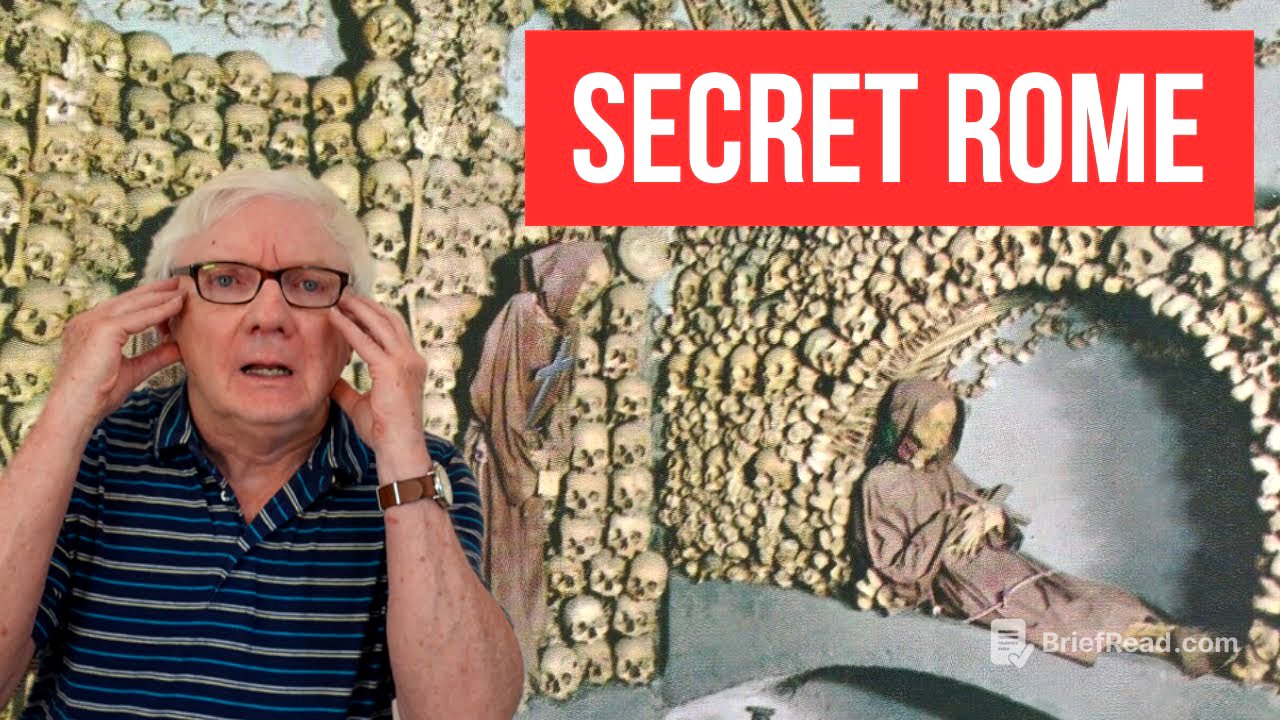TLDR;
This video showcases 10 lesser-known attractions in Rome, offering a deeper experience beyond the typical tourist spots. It covers historical sites, art, culinary experiences, and unique cultural spots.
- Villa Borghese: Explore Renaissance and Baroque art.
- Largo di Argentina: Discover the site of Julius Caesar's assassination and a cat sanctuary.
- Testaccio Market: Enjoy authentic Roman cuisine.
- Baths of Caracalla: Visit ancient Roman public baths.
- Aventine Keyhole: Get a unique view of St. Peter's Basilica.
- Vicus Caprarius: Explore an underground Roman water system.
- Villa Farnesina: Admire Renaissance frescoes.
- Capuchin Crypt: See artistic displays of skeletal remains.
- Via Appia: Bike or walk along an ancient Roman road.
- Quartiere Coppedè: Explore a whimsical residential neighborhood.
Villa Borghese [0:42]
The Villa Borghese is a museum and gardens that features a collection of Renaissance and Baroque art. Commissioned by Cardinal Scipione Borghese in the 17th century, the villa houses masterpieces by artists such as Raphael, Titian, Caravaggio, and Bernini. Bernini's sculptures, including David, The Rape of Proserpina, and Apollo and Daphne, are particularly notable for their detail and realism. The gardens surrounding the villa are open to visitors, requiring a separate ticket for entry.
Largo di Argentina [2:24]
Largo di Argentina is an archaeological site in Rome that contains layers of history from the Roman Empire to the present day. The site features well-preserved temples dating back to the 3rd and 4th centuries BC. It is also the location where Julius Caesar was assassinated in 44 BC. In addition to its historical significance, Largo di Argentina serves as a sanctuary for Rome's stray cat population, which are protected and fed by volunteers.
Testaccio Market [3:25]
The Testaccio Market is a culinary destination in Rome that offers a taste of authentic Roman cuisine. With over 100 stalls, the market is a place where locals shop for produce, fresh fish, meats, cheeses, and homemade pasta. Visitors can sample prepared foods such as piadina, supplì, pizza, and pasta. When shopping for produce, it is customary to point to the desired items and have the shopkeeper handle them.
Baths of Caracalla [4:31]
The Baths of Caracalla are ancient public baths from the Roman Empire, completed around 216 BC and used until the 6th century. The complex included gymnasiums, shops, and libraries with Latin and Greek texts. It featured swimming pools and various rooms for cold, hot, and warm baths, accommodating up to 1,600 bathers. Decorated with mosaics, frescos, carvings, and statues, its design inspired New York's Pennsylvania Station and the Senate building in Ottawa, Canada.
Aventine Keyhole [6:03]
The Aventine Keyhole offers a unique framed view of St. Peter's Basilica in Vatican City. Peeking through the keyhole in a green door, which marks the entrance to the Knights of Malta, one can see the dome of St. Peter's perfectly framed by an avenue of trees.
Vicus Caprarius [6:31]
The Vicus Caprarius, also known as the city of water, is an underground archaeological site located 30 feet below street level in Rome. Discovered during construction in the late 20th century, it showcases the city's ancient water infrastructure, including tunnels and channels dating back to the first century AD. These channels served as a distribution network for local houses and buildings. The site gets its name from the Latin word "capra," meaning she-goat, due to a mosaic found during excavation.
Villa Farnesina [7:33]
The Villa Farnesina, built between 1506 and 1510 for the wealthy banker Agostino Chigi, features original frescoes by Raphael and other Renaissance artists. Raphael's "Triumph of Galatea" and the vaulted ceiling of the "Loggia of Cupid and Psyche" are highlights. The villa's garden contains various species of citrus trees with unique-looking fruits.
Capuchin Crypt [8:45]
The Capuchin Crypt, part of the Church of Santa Maria della Concezione dei Cappuccini, contains the skeletal remains of 3,700 friars arranged in artistic and decorative patterns. The crypt is divided into chapels, each with a theme, such as the Chapel of the Pelvises and the Chapel of the Skulls. A plaque in the crypt conveys the message: "What you are now, we once were; what we are now, you shall be."
Via Appia [10:13]
The Via Appia, or Appian Way, was an important road connecting Rome to its empire. On Sundays, it is closed to traffic, allowing walkers, cyclists, and horseback riders to use it freely. Constructed in 312 BC for military purposes, it eventually extended 300 miles to Brindisi. Along the way, remains of temples and Roman structures can be seen, with chariot wheel imprints visible in the stones. Spartacus, the famous slave leader, was crucified here in 71 BC.
Quartiere Coppedè [12:21]
The Quartiere Coppedè is a residential neighborhood in Rome designed by architect Gino Coppedè between 1915 and 1927. It features whimsical architecture with sculptures, mosaics, and motifs. The entrance includes an opulent chandelier. Key sites include the Palazzo del Ragno (Palace of the Spider) and the Fontana delle Rane (Fountain of the Frogs), where the Beatles once took a dip in 1965.








